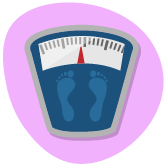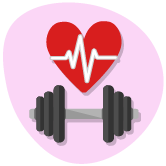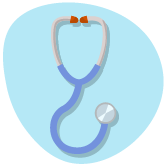What is breast cancer? [1]
Breast cancer is a malignant tumour that begins in the cells of the breast. The disease occurs mainly in women, but men can get it too.
Breast cancer is the most common cancer in women worldwide. [2]
Risk factors you can’t control [1,3,4]:
The exact cause of breast cancer remains unknown, yet certain factors are linked to the possibility of getting the disease. They are as below:
- Gender: Being a woman is the main risk for breast cancer, although 1% of men can also get the disease.
- Age: The risk of getting breast cancer increases as a woman gets older.
- Genetic risk factors: Damage to certain genes (due to inherited or environmental changes) increases the risk of breast cancer.
- Family history: Breast cancer risk is higher among women whose first-degree blood relatives have this disease. If one’s mother or sister has breast cancer, the risk of getting the disease increases.
- Personal history: A woman with cancer in one breast has a greater chance of getting new cancer in the other or same breast.
- Breast tissue: Women with denser breast tissue; or certain non-cancerous changes in the breast; have a higher risk of breast cancer. Dense breast tissue can also make it harder for doctors to spot cancer on mammograms.
- Menstrual periods: Women who began having periods early (before age 12) or who went through menopause after the age of 55 have an increased risk of breast cancer.
- Breast radiation early in life: Having received radiotherapy in childhood or adolescence increases the risk of developing breast cancer in adulthood.
Risk factors you can control [1,3,4]:
- Hormonal contraceptives: Women using them have a greater risk of breast cancer than women who have never used them.
- Hormone replacement therapy (HRT): HRT, which is used to help relieve the symptoms of menopause, increases the risk of breast cancer.
- Alcohol: Studies have shown that breast cancer risk increases with the amount of alcohol a woman drinks.
- Being overweight or obese is linked to a higher risk of breast cancer, especially for women after menopause.
- Tobacco smoke: Smoking and exposure to second-hand smoke (passive smoking) on a regular basis appear to increase the risk of breast cancer.
- Some other uncertain or unproven risk factors include antiperspirants, underwire bras, pollution, breast implants, etc.
How can breast cancer be prevented? [1,3,4]
Some lifestyle changes help in the prevention of breast cancer.

Diet

Weight

Exercise

Regular check-ups

Breastfeeding
- Diet: A healthy diet with a variety of foods that include lots of fruits, vegetables; choosing whole-grain foods; limiting alcohol consumption and meats that are high in fat; avoiding smoking.
- Weight: Achieving or maintaining a desirable weight.
- Exercise: Can improve physical and emotional health and play a role in preventing cancer.
- Regular check-ups: Getting the necessary exams and check-ups done regularly, especially in those who have a family history or relatives with breast cancer.
- Breastfeeding: Breastfeeding can lower breast cancer risk, especially if a woman breastfeeds for longer than one year.
What are the signs and symptoms of breast cancer? [4]
Early cancer of the breast usually has no symptoms. Later, as cancer grows, it may cause a lump or mass that can be felt in the breast. Other signs of breast cancer include the following:
- Swelling of all or part of the breast
- Skin changes like dimpling, scaling, thickening or redness
- Nipple pain or change in how the nipple looks
- Abnormal nipple discharge
- A lump in the underarm area
- Rarely breast pain
How can breast cancer be diagnosed? [1,4,5,6]
To help diagnose cancer at an early stage involves screening - that is, looking for cancer before a person has any symptoms.
- Breast self-examination - Checking one’s own breasts for lumps, changes in the size or shape of the breast, or any other changes in the breasts, skin, nipples or armpits.
This should be done on monthly basis, starting from 20 years of age.
Steps:
- Stand in front of a mirror with your hands on your hips. Check the appearance of both breasts - look carefully for changes to any part of your breasts, and whether both nipples are at the same level.
- Still standing in front of the mirror, raise both arms over your head. See if both breasts move in the same way. Pay attention to both nipples to see if there are any changes like dimples or bumps or retraction. Look towards the armpits for any swelling as breast tissue extends to that area.
- Place your left arm behind your head and apply gentle pressure to the left breast with the fingers of your right hand. Use a circular motion, being sure to cover the entire breast area. Also, check the armpits. Switch sides and repeat this process on the right breast.
- Check both nipples. Using your index and middle finger of the right hand, gently squeeze the left nipple and pull it forward. Check if the nipple springs back into place and if there is any fluid that leaks out. Do the same for the right nipple.
Women should be familiar with how their breasts normally look and feel and report any changes to a healthcare provider. [4]
Clinical breast examination - Breasts examined by a doctor. It should be done regularly after 30 years of age.
- Mammography (X-ray of the breast) - Helps find breast cancer early. The Cancer Association of South Africa advocates a mammogram every year for all women from age 40.
- Other - Biopsy (sampling of suspected tumour tissue for microscopic examination), magnetic resonance imaging (MRI) or sonography of the breast can also be done to detect breast cancer.
Your doctor will decide the tests that are necessary; all of them may not be done.
How can breast cancer be treated? [1]
Various therapies are used for the treatment of breast cancer e.g. removal of tumour (surgery), killing cancer cells with drugs (chemotherapy) or radiation (radiotherapy). Depending on the size and spread of cancer, treatment can include any of these therapies or a combination.
References:
1. Breast Cancer: A Guide for Patients. ESMO Available at: https://www.esmo.org/content/download/6593/114959/file/EN-Breast-Cancer-Guide-for-Patients.pdf.
2. Bray, F. Global Cancer statistics 2018. GLOBOCAN (2018). Available at: http://gco.iarc.fr/.
3. Tidy, C. Breast Cancer. (2014). Available at: https://patient.info/pdf/4807.pdf#.
4. Cancer Association of South Africa (CANSA) Fact Sheet on Metastatic Breast Cancer. 1–18 (2016).
5. Breast Check Guide. Pink Drive (2015). Available at: https://www.pinkdrive.co.za/wp-content/uploads/2015/08/PinkDrive-Self-Breast-Examination-Flyer.pdf.
6. Facts sheet on Effective Radiation received from routine mammography. 1–13 (2017). Available at: https://www.cansa.org.za/files/2017/04/Fact-Sheet-Effective-Radiation-Received-from-Routine-Mammography-April-2017.pdf.